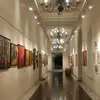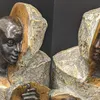Joy of giving: Oorja brings art with a cause to Bengaluru
Artist and curator, M G Doddamani brings the second edition of ‘Oorja 2020’ a 10-day art show that is currently being held at the Taj West End
An art show that will support the cause of Bembala is currently underway in Bengaluru, curated by artist,
M G Doddamani, who is an artist himself. Bembala is an initiative of Whitfield Rising (a citizens' group) that provides support and guidance to women and children facing abuse and violence.
The art show, called ‘Oorja’, which means ‘energy’ in Sanskrit, aims at getting people to observe and enjoy art, as they examine the artistic work that is on display at the event.
Doddamani completed his Bachelors of Fine Arts (BFA) as a top ranker and gold medallist and went on to get his MFA from Shantiniketan. His works have been displayed in many private and public collections in India and overseas. He has also won many awards, such as the National Award, AIFACS, New Delhi, and the State Lalit Kala Academy.
As an artist who has been curating art for over twenty years, he likes to encourage young aspiring artists to pursue their dreams. Ten of the 24 artists who are portraying their work at the Oorja show are Doddamani’s own students, who he has supported and helped, so that they could hone their craft and artistic skills.
The show features over 80 works from 24 artists, including popular senior artists such as Gurudas Shenoy, Basuki Das Gupta, and JMS Mani.

Paintings by Rama Suresh and Basuki Dasgupta.
In an exclusive interview with YS Weekender artist, curator, and teacher Doddamani talks about the joy he feels at seeing the work of his students, the ideas and inspiration behind curating Oorja and more…
YSW: What was the inspiration behind Oorja?
MGD: Oorja means ‘energy’ in Sanskrit, and comprises many different areas in life. It could be writing, art or dance. It is the internal desire to explore this energy through art on the canvas, or through any other artistic medium.
The first Oorja show took place in 2018 and in that show, there were around 24 artists from all over India. Ten of the artists were my students that year.
The idea behind this show was to combine the work of upcoming artists along with well-known artists, and provide them with a platform to showcase their work.
This will not only make the upcoming artists more confident but also help them to excel and go further. It is a wonderful feeling to have your work displayed along with the work of established artists.

Gallery at Taj West End, Bengaluru
YSW: What made you decide to showcase art for a cause?
MGD: Last year we donated the profits from our work to Stree Jagriti Samiti in support of individuals working in the unorganised sectors.
This year, we decided to support another cause, which involves women and children survivors of violence. That was when we decided to support the Bembala organisation in Bangalore.
It is an initiative of the citizens group, Whitfield Rising, and a free and confidential volunteer run support centre for women and children who face abuse and violence. Thirty per cent of our profits from the work of the artists will be donated to Bembala.

Artist and curator M G Doddamani with his work 'Gandhiji and the Burning Threads'
YSW: - Does every painting in the exhibition have a story? Does it stem from an experience/idea/ muse?
MGD: - Each artist has his or her own unique ideas and thinking process, and usually their paintings are a result of their experiences. A lot of these experiences come from their day-to-day interactions with society and what they observe and see.
Most of the paintings are based on a desire to explore. For example, in my paintings I usually focus on my Buddha art series, but for this show, I did a painting on Gandhi. It was called ‘Gandhiji and the Burning Threads.’ I wanted to show that society was very different at the time of Gandhiji as people were quite connected to one another and relationships were strong. However, today, all relationships are quite the opposite, and it’s quite sad to see the behaviour of humans deteriorating with time.
YSW: How do you help a student artist figure out what medium works for him or her?
MGD: I encourage my students to try out all the different mediums, from acrylic, oil, to watercolor, charcoal, mixed mediums and even sculptures. Later, I let them decide which areas they want to focus on and what they are interested in.

Artwork from Buddha series by Nivedita Gouda
YSW: How did you go about the selection process when it came to showcasing the ten upcoming artists?
MGD: When I do a show along with other well-known artists, it is very important to assess the standard and quality of the work. Some of my students have been painting for over 8 to 12 years. I selected the artists, based on the quality of the artwork. Quality and experience go hand in hand.

'Doors' series by artist Ritu Chawla Mathur
YSW: What is it like to curate an entire show?
MGD: I’ve been curating art shows for over twenty-five years. I used to run an art gallery called ‘Images Art Gallery’ on Infantry Road. I did a number of curated shows there (solo as well as group shows), besides art camps and workshops, such as poetry in collaboration with art, as well as dance with art.
Ever since I became a full-time artist, I didn’t want to leave behind my passion for curation. I wanted to use my ability and skill in curation to help other artists and talented individuals from the interiors of Karnataka and various other states in India, and give them the opportunity to showcase their talent.
A lot of my students are now doing their own solo shows, and have become professional freelance artists, and that is something wonderful for me to witness.

'Facets' portraits by Rosh Ravindran
YSW: Do you believe that art is not something that simply adorns the walls; it speaks to you?
As a human being, any form of art be it dance or writing is a form of inner expression. A thought or idea initially stems from the mind, but you express it in your own special way. Creativity is very important, because you have created something new, and it is unique only to you.

'New Born Puppies' By Venkatraman R
One of the artists in the show Venkataraman painted newborn puppies which he saw in a relative’s house, because that experience meant a lot to him. He wanted to showcase his love for animals through his art.
Vanaja, another artist and my student travels a lot and her work is often inspired by her travels and experiences.
Art definitely speaks to you, because what the artist expresses on a canvas may be his own experience or idea, but the viewer can interpret it differently.
So, two individuals can experience a very different reaction to a painting, because every person’s visual sense and the way they interpret space and colour is completely different.
(Edited by Asha Chowdary)









